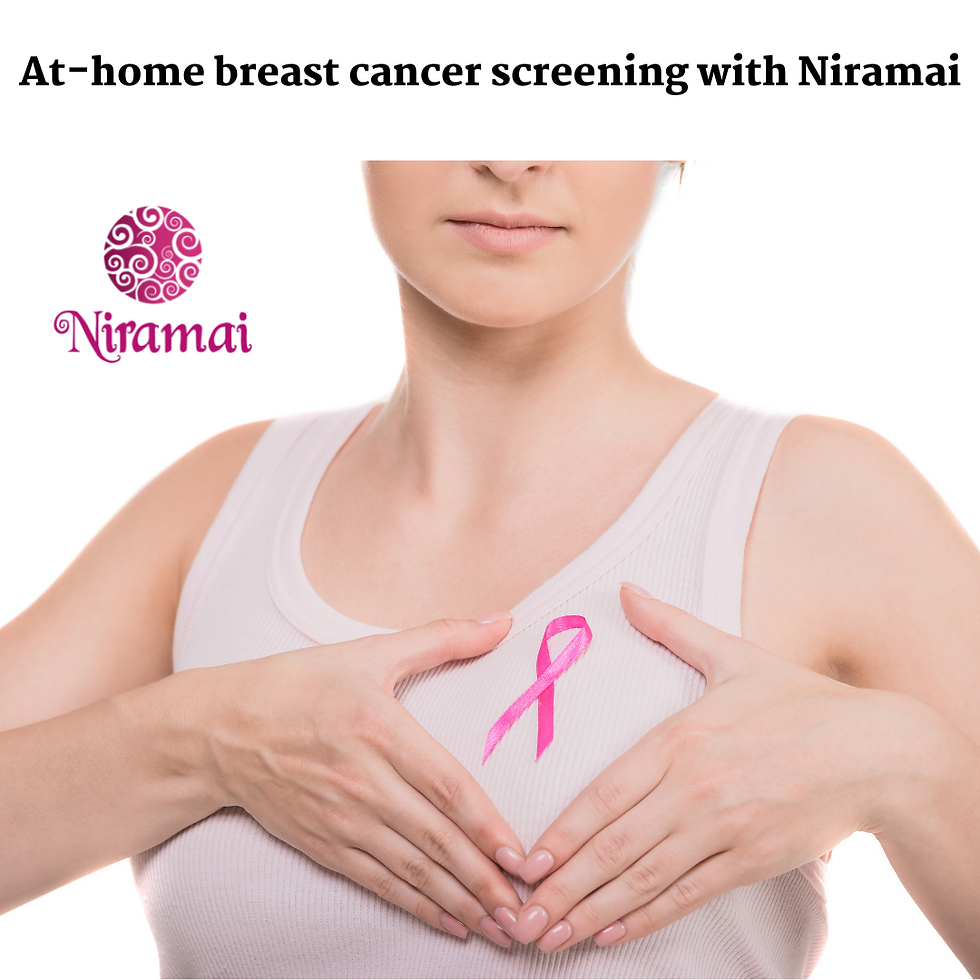Putting off your breast cancer screening, do it at home!
- Jan 20, 2022
- 5 min read
Updated: Jun 21, 2024

Did you know that an estimated 1,62,468 women in India were diagnosed with breast cancer in 2018? However, breast cancer does not have to be a death sentence, the gap lies in the need for early detection.
Currently, mammography is the go-to breast cancer screening method. Mammography detects whether or not there are small lumps in the breast by compressing the breasts between two plates and passing X-rays through it. Imagine an X-ray of a hand: the skeleton appears white. This is because anything that is hard is stopped by the X-ray and appears white. That is the principle behind finding small lumps in the breast. But in younger women, there's a lot of fibrous glandular tissue and hormonal activity so the whole breast appears white normally. As it is not possible to find a white spot in a white zone, the mammography technique does not work on women under 45 years of age.
It may not even work on women above 45 years of age as well as the lumps are best spotted when big which means that the cancer is already at a later stage. The efficacy of treatment at later stages is costlier and more uncertain. Furthermore, the mentality that ‘we will not get cancer’ leads to ‘so why should we spend 3000 rupees (or ~USD36)?’ All of these issues combined result in breast cancer cases in India going undetected.
A cousin’s fatal brush with breast cancer served as a wake-up call for Dr. Geetha Manjunath, an AI researcher and graduate from the Indian Institute of Science. She began reading about breast cancer and coincidentally met an imaging specialist who pointed her in the direction of thermal imaging. She spent a year working on thermal imaging software for breast cancer detection then quit her job when she realized that her innovation had the potential to save thousands of lives. She founded Niramai Health Analytix which has been creating a buzz because of its radiation-free, accessible, and affordable breast cancer screening innovation.
Impressed with the screening’s non-invasive, radiation-free, pain-free technology that is performed by a Niramai-trained female technician at the comfort of your home in under 20 minutes, we at Miyara have partnered with Niramai. If you are interested in knowing more or booking the test for you or a family member, sign up here.
How does the Niramai screening work?
As opposed to mammography’s use of X-ray, this technology uses thermal sensing. It is similar to the temperature measuring instruments that are seen everywhere because of COVID but has a much higher resolution and sensitivity. The screening device is kept in front of the person and within minutes, the whole body’s temperature is measured. Cancer cells are dividing at a much faster rate compared to the rest of the cells. This irregular and faster division results in an increase in temperature. So the cancer cell itself is at a much higher temperature when compared to the rest. The surrounding areas’ vascular activity increases too. This temperature variation is analyzed using a smart, artificial intelligence software that the Niramai team has developed.
What is the difference between thermography and Niramai’s Thermalytix software?
Thermography measures the temperature variation on the chest area and requires an expert to visually analyze temperature variations. Understanding minute temperature differences aren’t humanly possible, there are a lot of errors. While Niramai uses the same thermal camera, the rest of the process is completely different. Using sophisticated statistics and probability-based models this screening method is able to detect 117 different types of abnormal patterns or a combination of all of them in two minutes. That is a major difference in the smart software, whereas thermography is error-prone and requires the person to be screened twice.
Why should you get a Niramai screening?
1. Age
While mammography does not work as well on denser tissue and younger women
Thermal imaging does not depend on the density of the tissue. It looks at the temperature of the tissue or the abnormal tissue activity. It is irrespective of the density and irrespective of age.
2. Size of the lump
Mammography detects lumps at two centimetres
The thermal imaging method is able to detect at four millimetres, more than five times smaller.
3.Radiation
Mammography uses X-rays and are thus not radiation-free
Niramai’s technique simply measures temperature. The test can be done as often as required.
4. Cost
Niramai’s device is less than 1/10th the cost of a mammogram. This is very important for countries like India, where mass production is required. The Niramai team are even working on a mobile phone attachment!
5. Accessibility
Niramai’s screening method can be done at home. It’s portable and accessible!
6. Privacy
During the Niramai screening, the person enters the booth, sits in front of the device. Even the technician is outside the room! It's like a changing room experience, you just close the door and sit inside and nobody sees you without clothes.
Disclaimer: Thermography is approved by the Food and Drug Administration (FDA Code of Federal Regulations Sec. 884.2980) as an adjunctive test and does not replace mammography or any other anatomical imaging test. It is not intended for use by individuals for self-diagnosis or for self-evaluation.
At what age should you start breast cancer screening?
Any person above 25 years of age should get at least one screening done. Mammography is not recommended unless there's a high risk, so, we suggest the Niramai test. Getting a screening done at the age of 25 generates a score. Based on the score, you can decide whether you want to do it once in a year or two years from then.
In addition to that, a self-examination at least once a month is very important to do. You can fix the date as five days after the menstrual period is done for the month, stand in front of the mirror and then do the self-examination to look for any lumps or any discharge from the nipple. Apart from this, a clinical examination by a healthcare professional is recommended.
You can receive our guide to self-breast examination here
What’s next for Niramai?
Recently, Niramai has received approval for Europe, Africa and some parts of Asia.
The Niramai team is working to reduce the screening costs and make it more affordable and portable for villages. In fact, they are working on a very simple device to be used along with the phone.
Read related: Inspiring Journeys Episode 3 with Tithi Pandya, a breast cancer survivor
To book an at-home breast cancer screening please head to this link.
To learn more about breast cancer read our Breast Cancer Awareness 101 here. You can follow Niramai on their social media: Twitter, Instagram, LinkedIn.
Check out our other women's health products here
Disclaimer: Keep in mind that we may receive commissions when you click our links and make purchases. However, this does not impact our reviews and comparisons. We try our best to keep things fair and balanced, in order to help you make the best choice for you
Disclaimer: Opinions expressed belong solely to the content provider. Miyara Women does not undertake any financial/reputational/legal/misrepresentational impact or other obligations/ liabilities that may arise from the content.
About the author

Aishwarya Viswamitra is a science communicator with experience in science writing, podcast hosting and social media marketing. When she's not furiously typing a new article, you can find her curled up in a spot of sunlight.
Twitter: @a_viswamitra
Instagram: @_.twoinabillion._




Comments